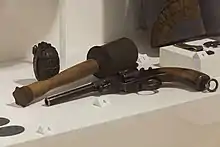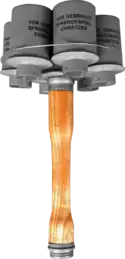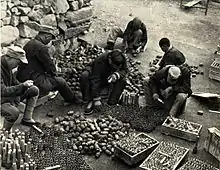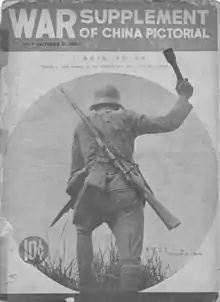Stielhandgranate
The Stielhandgranate (German for "stick hand grenade") was a German hand grenade of unique design. It was the standard issue of the German Empire during World War I, and became the widespread issue of Nazi Germany's Wehrmacht during World War II. The very distinctive appearance led to it being called a "stick grenade", or "potato masher" in British Army slang, and is today one of the most easily recognized infantry weapons of the 20th century.[1]


Origins
Germany entered World War I with a single grenade design: a heavy 750-gram (26 oz) ball-shaped fragmentation grenade (Kugelhandgranate) for use only by pioneers in attacking fortifications. It was too heavy for regular use on the battlefield by untrained troops and not suitable for mass production. This left Germany without a standard-issue grenade and improvised designs similar to those of the British were used until a proper grenade could be supplied.[2]
The "stick grenade" first appeared in the midst of World War I; it was introduced in 1915 for use by the German Empire's armed forces. As time went on, the design further developed, adding and removing certain features. Aside from its unique and unusual appearance, the Stielhandgranate used a friction igniter system, a method very uncommon in other nations but widely used in German grenades.
During World War I, the original design of the Stielhandgranate, under the name M1915 (Model 1915), was in direct technological competition with the British standard-issue Mills bomb series. The first design model of the Mills bomb – the grenade No. 5 Mk. 1 – was introduced the same year as the German Model 1915, but due to delays in manufacturing it was not widely distributed into general service until 1916. (There was a small period of time where German troops had large supplies of new Model 1915 grenades, while their British opponents only had a very small number.)
As World War I progressed, the Model 1915 Stielhandgranate was further improved with various changes. These received new designations corresponding for the year of introduction, such as the Model 1916 and the Model 1917.
Production variations
Model 1915 (M15)
| Model 1915 Stielhandgranate | |
|---|---|
.jpg.webp) | |
| Place of origin | German Empire |
| Service history | |
| In service | German Empire (1915–1918) |
| Used by | See Users |
| Wars | World War I |
| Production history | |
| Designed | 1915 |
| Specifications | |
| Filling | Trinitrotoluene |
Detonation mechanism | friction igniter and 4 1⁄2 second delay |
In 1915, industries of the German Empire designed and began production of the original Stielhandgranate, appropriately named "Model 1915" (M15). It utilized a priming system, unlike the percussion cap pin used in most grenades of the period. The easily recognizable "potato masher" shape is a result of a number of different styles and choices of the design. The grenade mounted a charge head within a sheet-steel cylinder atop a long hollow-wooden handle. Internally, the explosive – initially ammonal but later approximately 170 g (6.0 oz) of trinitrotoluene filling[3] – was connected to a detonator, and a pull cord ran from the detonator down the length of the hollow handle, emerging from the base. To use it, a soldier would simply pull the string downwards, dragging a rough steel rod through the igniter within the fuse. The rod's abrasive contact would cause sparks and a flame to light from within, setting the fuse burning. This fuse took approximately four and a half seconds to reach the detonator before exploding.
The British War Office report "WO 291/472 Performance and handling of HE grenades" gives an average figure for a standing throw of a Mills bomb as 27 m (30 yd), (23 m (25 yd) when crouched and 22 m (24 yd) lying prone). One issue that hand grenades of the time had was unpredictable rolling after landing. The Stielhandgranate did not suffer nearly as much, and in some respects not at all, from this problem as the handle together with the charge head resisted rolling. Instead of rolling straight down a hill or across rough terrain, the Stielhandgranate could create an axis for rotation: it would instead roll from side to side, because the charge head and length of the grenade acted as a balance. However, the additional length of the handle and the irregular overall shape meant that fewer grenades could be carried. It also took longer to prime the grenade than Allied counterparts such as the Mills bomb.
The Stielhandgranate primarily relied on a concussion blast effect, its thin metal container creating little fragmentation compared with many grenades of the time, such as the Mills bomb and the French F1 grenade, the later World War II American Mk 2 grenade, and the Soviet F1 grenade. Fragmentation grenades produced shrapnel which could wound enemy infantry over a large area, which made these types very useful in open areas such as fields, the blasted expanse of no man's land, beaches, spacious trenches, and wide city streets.
Concussion grenades, however, were primarily designed to stun opponents at close quarters with the blast of their explosive charge, thereby reducing resistance for the immediately following-up infantry assault closing with its target with rifles and bayonets. The Stielhandgranate was extremely effective and reliable in clearing enclosed areas, such as buildings, fortifications, and the fighting compartments of enemy tanks, although performance in wide open areas was less than satisfactory. The blast effect went only a limited distance before dying out, while pieces from an equivalent fragmentation grenade could fly hundreds of metres (it was not unrealistic to expect that metal shrapnel could create friendly fire casualties, especially in open areas).
Model 1916 (M16)
| Model 1916 Stielhandgranate | |
|---|---|
 A British Mills bomb grenade with a Model 1916 Stielhandgranate and a M1879 Reichsrevolver | |
| Place of origin | German Empire |
| Service history | |
| In service | German Empire (1916–1918) |
| Used by | See Users |
| Wars | World War I |
| Production history | |
| Designed | 1916 |
| Specifications | |
| Filling | Trinitrotoluene |
Detonation mechanism | friction igniter and 4 1⁄2 second delay |
The original M15 grenade suffered from a design issue. The pull cord which activated the grenade's fuse protruded from the base and could get caught in debris or clutter on the battlefields of World War I, causing the fuse to be ignited, and the grenade to explode on the belt of an unaware infantryman. This resulted in the introduction of the Model 1916 (M16).
Functionally identical to the M15, the M16 included a vital change in the base design. A small porcelain ball was placed at the base of the grenade, attached directly to the pull cord. This prevented the string from being exposed. The small bead was partially enveloped in the wooden handle, meaning that some force was needed to pluck it out. Operation was nearly identical, except that a soldier no longer needed to pull the string itself.
Model 1917 (M17)
| Model 1917 Stielhandgranate | |
|---|---|
| Place of origin | German Empire |
| Service history | |
| In service | German Empire (1917–1918) |
| Used by | See Users |
| Wars | World War I German Revolution |
| Production history | |
| Designed | 1917 |
| Specifications | |
| Filling | Trinitrotoluene |
Detonation mechanism | friction igniter and 4 1⁄2 second delay |
Another development of the Stielhandgranate was implemented during the later stages of World War I, affecting the priming system. The base of the Stielhandgranate's handle was slightly redesigned, and a metal cover cap was introduced. This cap concealed the porcelain bead and pull cord, allowing it to simply rest freely inside of the handle. The cover cap would simply be pulled off before using it as with the M16.
Model 1924 (M24)
| Model 1924 Stielhandgranate | |
|---|---|
 | |
| Place of origin | Weimar Republic |
| Service history | |
| In service | Weimar Republic (1924–1933) Nazi Germany (1933–1945) |
| Used by | See Users |
| Wars | Spanish Civil War World War II |
| Production history | |
| Designed | 1924 |
| Specifications | |
| Mass | 595 g (1 lb 5.0 oz) |
| Length | 365 mm (1 ft 2.4 in) |
| Diameter | 70 mm (2.8 in) |
| Filling | Trinitrotoluene |
| Filling weight | 170 g (6.0 oz) |
Detonation mechanism | friction igniter and 4¹/₂ second delay |
Upon the German Empire's defeat at the conclusion of World War I, the total and complete collapse of industrial capability and military strength of Germany left many projects and ideas lost and forgotten for a number of years. When the newly created Weimar Republic progressively began to repair the both physical and economic devastation, a slow rebuilding of the armed forces was allowed under the limitations set by the allies.
The Weimar Republic revived the Stielhandgranate, and created a new version in 1924, the "Model 1924 Stielhandgranate" (M24). While retaining the same explosive and fuse, the main distinction between the M24 and the original M15 is a slightly shorter charge head and the removal of a belt carry clip. Another change in the design was a lengthening of the wooden handle. The intent of these design alterations was simply for mobility; German soldiers could easily (and often did) tuck the grenade in behind their uniform's belt, held tight and secure. Being slightly lighter, and smaller in thickness, this improved overall use.
The M24 is well known as the standard hand grenade of the armed forces of the Wehrmacht during World War II. Adapting to the rapidly changing field of modern warfare, German soldiers would carry the M24 directly in front, allowing quick and easy access. However, in the later years of the war it was often advised to carry them in a different manner, as it was very likely any sort of explosion or heat could light the fuse from the grenade on the belt, resulting in unnecessary casualties.
The Model 24 Stielhandgranate was stored in specially designed crates during transport, which could carry up to 15 individual grenades. As a safety precaution, units of the Wehrmacht were advised to only insert the actual fuse assemblies when about to go into combat. Later in the war, however, many soldiers of the Wehrmacht would always have their weapons ready, due to the fierceness seen in the Soviet Red Army in the east and the progressive advance of the Allies on the Western Front. During production, a reminder was stenciled on each explosive charge: Vor Gebrauch Sprengkapsel einsetzen ("Before use insert detonator").
The Model 1924 was rather ineffective by itself at damaging or disabling an enemy armored vehicle or destroying fortifications. It also lacked the shrapnel effect of most other grenades of the time. To overcome these faults, various German industries during World War II produced a number of variants that widened the utility and capability of the M24.
K variant
During numerous operations of the invasion of the Soviet Union, the Wehrmacht found that under freezing conditions the M24's fuse could fail to ignite. In response, a variant with a cold-resistant explosive was developed and supplied to most units deployed on the eastern front (especially into present-day Russia). During production, the metal charge head was marked with a letter K, referring to the German word Kalt (English: cold).
Nebelhandgranate
The Wehrmacht lacked a proper smoke grenade to allow infantry to cover advances or retreats, or blind foes while assaulting a position. To solve this, Germany designed and produced a nebel (English: fog) grenade that was essentially an M24 with a remodeled fuse mechanism and the explosive filler replaced with a smoking material; smoke was emitted from small holes cut into the underside of the metal charge head. In addition to markings inscribed on the charge head, a large white band painted onto the handle distinguished it from a standard M24. Later, a relief texture was added to the handle to distinguish it by touch. This variant is often referred to as a Nebelhandgranate (English: fog hand grenade).
Training variants
Like most of the forces that took part in World War II, the Wehrmacht produced inert (not able to explode) versions of the standard-issue grenade, designed to aid recruits on how to properly throw and operate the weapon during training.[4] Called Übungs-Stielhandgranate 24, they were characterized by bright red charges with holes going throughout.[5]
Improvised "bundle charge"

To counter the lack of effectiveness against hard targets such as tanks and buildings, a common solution was created in the form of an improvised "bundle charge". The charges of a number of M24 grenades – their handles and fuses removed – would be strapped around a complete grenade, usually with simple rope, cloth, or metal wire. These could be crafted with up to six additional charges, and in battle the most common styles to see were the addition of four or six. Unofficially, these improvised bundle grenades were known as Geballte Ladung (English: bundled charge or concentrated charge).
As a result of this cost-effective and reliable solution, the standard infantryman of the Wehrmacht could quickly improvise a grenade with up to seven times the explosive power. However, the added weight made it more difficult to throw, and the increased size meant that it was not practical to carry with one hand and that far fewer could be carried. These factors meant that infantry squads, if faced with an armored enemy, would have to close to a reduced range if they wanted to use the bundle charges. During the early years of World War II, there was little in terms of truly effective German handheld weaponry designed to fight hard targets such as armored vehicles and structures, and even later in the war this style of bundle grenade remained useful to the common Wehrmacht infantryman.
Foreign designs
Separate from Nazi Germany, the Model 24 Stielhandgranate was used globally during World War II. A number of nations either directly acquired or purchased stockpiles of the grenade, or created similar versions with very slight adjustments.
Chinese Stielhandgranate

During the Second Sino-Japanese War, the Chinese designed and produced a grenade based on the German Model 1924 which was used by the National Revolutionary Army. Such grenades were the main type of grenade used by Chinese forces during the whole war. It was a simple design and was mass-produced in large numbers, not only in arsenals (primarily in the 1st, 11th, 21st, 24th, 25th and 30th), but also by hand with the help of civilians.[6] Hundreds of thousands of grenades were produced each month.[6] There were some variations in the design, but most followed the same basic pattern: A wooden handle with a round or cylindrical head and a slow burning fuse. The charge was a mixture of TNT and nitride potassium, and they were generally somewhat weaker than their German counterpart.[6][7] In 1939, a new design with a smaller handle and much more compressed explosive load began trials. The resulting model was lighter and more powerful and the ordnance office decreed it to be the new standard type in all arsenals.[6][8] Just like German troops, Chinese soldiers often bundled grenades together to blast open fortifications, vehicles and the like. Another tactic was to tie a grenade to a long bamboo stick, for example to stick up over a wall or into a window.[6]
Following World War II, the People's Liberation Army developed a standardized variant of the grenade, designated "Type 67". It became the standard grenade for the PLA and was also supplied in huge numbers to the Viet Cong and the People's Army of Vietnam during the Vietnam War.[9]
Type 98

In 1938, the Imperial Japanese Army copied the Chinese Stielhandgranate and produced them at a Japanese factory in Manchuria. These were designated the "Type 98". Unlike both the original German M24 Stielhandgranate and its Chinese counterpart, the Type 98 was a fragmentation grenade. The charge, however, was weak and only contained 85 g (3 oz) of picric acid (more powerful but less safe than TNT). The weapon had a pull ring attached to the igniting cord, and the fuse delay was 4 to 5 seconds (varying from grenade to grenade). Like the Chinese grenades, it was a crude copy of the Model 1924 and a number of issues plagued its effectiveness.[8]
Model 1943 (M43)
As the war progressed and the Wehrmacht began to lose strength and momentum against the Soviet Union, Nazi Germany began implementing measures to ensure the safety and reliability of its weapons. The Wehrmacht needed to minimize the risk of injury or death caused by faults of its military equipment, munitions, and weapons.
Germany's industrial capabilities decreased as the war progressed. As a result, the production of munitions, equipment, and weaponry had to become easier and more cost-efficient. Some of these, like the Maschinengewehr 42, were more than a success on the level of resources, but many were only simpler and less-expensive versions of an existing item. The Model 1924 grenade was technically "succeeded" by the Model 1943 (M43). This was a copy with a few expensive parts removed or replaced for easier production – and because of this, the original remained in service with Wehrmacht infantry right to the end of the war.
The only significant alterations in the M43's design was the inclusion of a self-contained detonator, meaning that the fuse and the explosive were directly linked. The M43 also utilized an entirely different fuse assembly, very similar to that of the Model 39 grenade, another German hand grenade of the time.
Users

Following its introduction in 1915, the Stielhandgranate has been used globally during a number of different conflicts, most significantly during both world wars.
A list of the various users of the Stielhandgranate is as follows:
| User | Type of service | Self-manufactured | Version | ||||||
|---|---|---|---|---|---|---|---|---|---|
| Model 1915 | Model 1916 | Model 1917 | Model 1924 | Model 1943 | |||||
| Official users | |||||||||
| Full military service | ✓ | ✓ | ✓ | ✓ | X | X | |||
| Full military service | ✓ | X | X | X | ✓ | X | |||
| Full military service | ✓ | X | X | X | ✓ | ✓ | |||
| Unofficial users | |||||||||
| Leased/purchased | X | ✓ | ✓ | ✓ | X | X | |||
| Leased/purchased | X | X | X | X | ✓ | ✓ | |||
| ? | X | ? | ? | ? | ✓ | ✓? | |||
| Leased/purchased | X | X | X | X | ✓ | X | |||
| ? | ? | ? | ? | ? | ? | ? | |||
| Captured/scavenged | X | X | X | X | ✓ | ✓ | |||
| Captured/scavenged | X | ✓ | ✓ | ✓ | X | X | |||
| User | Type of service | Version | ||
|---|---|---|---|---|
| Chinese copies | Type 98 | Type 67 | ||
| Captured/local design produced | ✓ | ✓ | X | |
| Local design produced | ✓ | X | X | |
| Local design produced | ✓ | X | ✓ | |
| Leased/purchased | X | X | ✓ | |
See also
- List of World War II firearms of Germany
- List of German military equipment of World War II
- Model 39 grenade – German "egg" type hand grenade
- RGD-33 grenade – Early WWII Soviet stick grenade
- Splitterring – A fragmentation sleeve for the M24 and M43
References
- Bishop (1998), The Encyclopedia of Weapons of World War II, New York: Orbis Publishing Ltd., ISBN 0-7607-1022-8.
- "Intro & History", Bergflak's Lounge
- Chen, Peter. "Model 24 Stielhandgranate Grenade". ww2db. Lava Development LCC. Retrieved 8 March 2017.
- http://www.bergflak.com/m24ub.html
- "Original German WWII Training M24 Stick Grenade by Richard Rinker - Dated 1936". International Military Antiques. Retrieved 2021-01-13.
- Shih, Bin (2018). China's Small Arms of the Second Sino-Japanese War (1937-1945). pp. 232–235.
- McWilliams, Bill (2015). On Hallowed Ground: The Last Battle for Pork Chop Hill. Open Road Media. p. 390. ISBN 9781504021517.
- Rottman, Gordon (2009), World War II Axis Booby Traps and Sabotage Tactics, New York: Bloomsbury Publishing plc, p. 23, ISBN 978-1-8460-3450-3.
- Peverelli, Lex. "Stick Grenade Type 67". lexpev.nl. Lex Peverelli. Retrieved 2 April 2017.
- Tibor, Rada (2001). "Német gyalogsági fegyverek magyar kézben" [German infantry weapons in Hungarian hands]. A Magyar Királyi Honvéd Ludovika Akadémia és a Testvérintézetek Összefoglalt Története (1830-1945) (in Hungarian). II. Budapest: Gálos Nyomdász Kft. p. 1114. ISBN 963-85764-3-X.
External links
| Wikimedia Commons has media related to Stielhandgranate. |